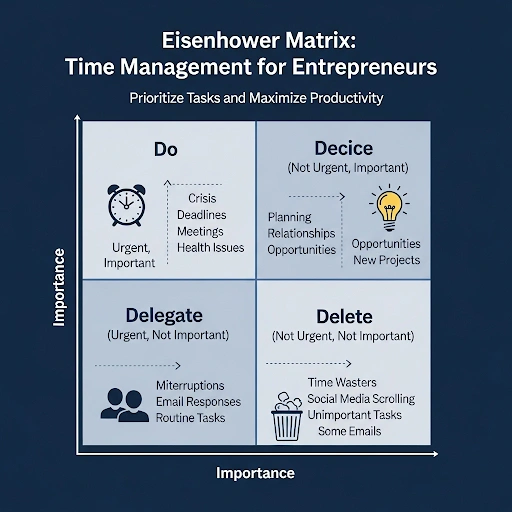Stop drowning in tasks and start making strategic moves with smart time management hacks entrepreneurs can actually use. Discover the kind of time management hacks entrepreneurs rely on to focus on what matters most. These simple but powerful time management hacks entrepreneurs apply every day are what separate thriving founders from the merely busy. In the end, it’s the consistent time management hacks entrepreneurs practice that turn overwhelming schedules into sustainable success.
The coffee is brewing, your laptop is open, and a wave of notifications is already crashing against your focus. As an entrepreneur, you wear a dozen hats: CEO, marketer, salesperson, HR manager, and sometimes, even the IT department. The to-do list is a living entity, growing faster than you can tackle it. If you’ve ever ended a 12-hour workday feeling like you were busy all day but accomplished nothing truly important, you’re not alone. The relentless pace of modern business demands more than just hard work; it demands smart work. This guide is your blueprint for reclaiming your most valuable asset—your time. We will dive deep into actionable time management hacks for busy entrepreneurs, designed to transform your chaotic schedule into a powerful engine for growth and well-being.
- What is Strategic Time Management Hacks Entrepreneurs Can Use?
- Why Mastering Your Time is a Non-Negotiable Skill
- The Hacks: Core Frameworks for Time Mastery
- A Founder’s Schedule in Action
- Comparison: Popular Productivity Tools
- Common Time Management Traps to Avoid
- Expert Tips and Best Practices
- Frequently Asked Questions (FAQ)
- Conclusion: From Busy to Effective
What is Strategic Time Management Hacks Entrepreneurs Can Use?
Time management hacks entrepreneurs often get wrong is thinking it means cramming more tasks into the day. For founders, that only leads to burnout. True time management is focusing energy on what brings the biggest return. These time management hacks for entrepreneurs help you act with intention, not just stay busy. With the right time management hacks entrepreneurs avoid distractions, cut busywork, and focus on growth. In the end, time management hacks for busy entrepreneurs create space for what truly matters.
In 2025, this strategic approach is more critical than ever, making time management hacks entrepreneurs use a real game changer. With the rise of AI-powered distractions and the constant pressure to be ‘always on’, proven time management hacks entrepreneurs apply help create space for real focus. The future of entrepreneurship isn’t about outworking everyone; it’s about leveraging smart time management hacks entrepreneurs already trust to think deeper and act sharper. These productivity tips, much like practical time management hacks entrepreneurs rely on, are not just about getting more done; they’re about getting the right things done.

Why Mastering Your Time is a Non-Negotiable Skill
Adopting a strategic approach to your schedule yields benefits that compound over time, and this is why time management hacks entrepreneurs practice are so valuable. The right routine builds momentum, while simple time management hacks entrepreneurs apply can directly boost focus and clarity. Over weeks and months, consistent use of time management hacks entrepreneurs rely on helps sharpen decision-making. The impact of these time management hacks entrepreneurs follow is seen not only in business growth but also in long-term mental health.
Skyrocket Your Productivity and Focus
By intentionally scheduling blocks for “deep work,” you move from a reactive state to a proactive one. Instead of constantly switching contexts between emails, calls, and tasks—which research shows kills productivity—you can dedicate uninterrupted hours to complex problem-solving, product development, or strategic planning. This is how you produce high-value work that moves the needle.
Drastically Reduce Stress and Avoid Burnout
Chaos breeds stress. When your day is a constant barrage of unplanned demands, your cortisol levels spike, leading to exhaustion and burnout. A structured schedule creates predictability and control. It allows you to build in time for rest, exercise, and family, which are essential for long-term entrepreneurial stamina. Learn more about how to avoid founder burnout in our detailed guide.
Enhance Strategic Decision-Making
You can’t see the forest for the trees when you’re constantly putting out fires. Effective time management carves out the mental whitespace needed for high-level thinking. When you’re not bogged down in the day-to-day minutiae, you can focus on the big questions: Where is the market heading? What is our next big opportunity? How can we innovate our business model?
The Hacks: Core Frameworks for Time Mastery
These are not just tips; they are proven systems. Pick one or two that resonate with you and implement them consistently.
The Eisenhower Matrix: Separate the Urgent from the Important
Developed by President Dwight D. Eisenhower, this framework helps you prioritize tasks by categorizing them into four quadrants. This simple grid is one of the most powerful time management hacks for busy entrepreneurs because it forces you to differentiate between what feels urgent and what is truly important.
- Quadrant 1 (Urgent & Important): Crises, deadlines, pressing problems. **Do these immediately.**
- Quadrant 2 (Not Urgent & Important): Strategy, relationship building, planning, new opportunities. **Schedule time for these.** This is where growth happens.
- Quadrant 3 (Urgent & Not Important): Some meetings, many interruptions, other people’s minor issues. **Delegate these whenever possible.**
- Quadrant 4 (Not Urgent & Not Important): Trivial tasks, time-wasters, some social media. **Eliminate these.**

Time Blocking: Become the Architect of Your Day
Instead of working from a to-do list, time blocking involves assigning every part of your day to a specific task or activity. This means scheduling blocks for email, deep work, meetings, lunch, and even breaks. It’s a proactive approach that ensures your priorities get the time they deserve on your calendar.
The Pomodoro Technique: Master Focus in 25-Minute Sprints
This technique, developed by Francesco Cirillo, uses a timer to break down work into focused 25-minute intervals, separated by short breaks. It’s incredibly effective for overcoming procrastination and maintaining high levels of concentration during long work sessions.
Eat the Frog: Conquer Your Most Dreaded Task First
Coined by Brian Tracy, this principle states that you should tackle your most challenging and important task (the “frog”) first thing in the morning. By getting it out of the way, you build momentum and ensure that even if the rest of the day gets derailed, you’ve already accomplished something significant.
A Founder’s Schedule in Action
Let’s see how Alex, the founder of a growing SaaS startup, structures their Monday using these techniques.
- 8:00 AM – 8:30 AM: Daily Planning. Review Eisenhower Matrix, identify today’s “frog.”
- 8:30 AM – 10:30 AM: Deep Work Block (Eat the Frog). Focus on a critical product feature. Phone on silent, notifications off. Two Pomodoro sessions (25 min work, 5 min break).
- 10:30 AM – 11:00 AM: Email & Slack Batch. Process urgent communications only.
- 11:00 AM – 12:00 PM: Team Leadership Meeting.
- 12:00 PM – 1:00 PM: Lunch & Walk. Complete break away from screens.
- 1:00 PM – 3:00 PM: Deep Work Block. Strategic planning for Q4 marketing campaign.
- 3:00 PM – 4:00 PM: Sales & Investor Calls (Batched).
- 4:00 PM – 4:30 PM: Email & Slack Batch. Final check-in.
- 4:30 PM – 5:00 PM: End of Day Shutdown. Plan tomorrow’s priorities.
Comparison: Popular Productivity Tools
| Tool | Best For | Pros | Cons |
|---|---|---|---|
| Asana | Complex team projects and workflows. | Powerful, great for collaboration, many integrations. | Can be overwhelming for solo founders or small teams. |
| Trello | Visual task management (Kanban). | Intuitive, flexible, great free version. | Lacks advanced features for complex projects. |
| Notion | All-in-one workspace (notes, tasks, wikis). | Extremely customizable, powerful databases. | Steep learning curve, can be slow. |
Common Time Management Traps to Avoid
1. The Myth of Multitasking
Trying to do multiple things at once doesn’t make you more productive; it just means you’re doing multiple things poorly. Each time you switch tasks, you incur a “cognitive switching penalty.” Avoid it by committing to single-tasking during your focus blocks.
2. Ignoring the Power of Breaks
Your brain is a muscle, not a machine. Working for hours on end without a break leads to diminishing returns and poor decision-making. Avoid it by scheduling short breaks (using the Pomodoro technique) and a longer break for lunch, preferably away from your desk.
3. Refusing to Delegate
The “I can do it better/faster” mindset is a major growth bottleneck. As a founder, your job is to work *on* the business, not *in* the business. Avoid it by identifying tasks that fall into Quadrant 3 of the Eisenhower Matrix and actively finding someone to delegate them to.
Expert Tips and Best Practices
- Conduct a Weekly Review: Spend 30-60 minutes every Friday afternoon or Monday morning reviewing the past week and planning the next. This habit, central to systems like GTD, ensures you start each week with clarity and purpose.
- Batch Similar Tasks: Group all your calls, emails, or administrative tasks into dedicated blocks. This minimizes context switching and allows you to get into a rhythm.
- Set and Defend Your Boundaries: Your time is your most valuable resource. Learn to politely say “no” to requests that don’t align with your priorities. Use tools to block off focus time on your calendar so colleagues know not to interrupt.
- Leverage Technology Wisely: Use automation tools like Zapier to handle repetitive tasks. Explore AI assistants to summarize long documents or draft initial emails. Technology should serve your focus, not fracture it. For more on this, see this Harvard Business Review article.

Frequently Asked Questions (FAQ)
Q: How do I stick to a time management system when my schedule is so unpredictable?
A: The goal isn’t a rigid, unbreakable schedule. It’s a framework. Time block your priorities, but also schedule a “flex block” each day to handle the inevitable unexpected issues that arise.
Q: What’s the best first step if I feel completely overwhelmed?
A: Start with a “brain dump.” Write down every single task, idea, and worry on your mind. Then, use the Eisenhower Matrix to sort them. This act of externalizing and prioritizing brings immediate clarity.
Q: How long does it take to see results from these techniques?
A: You’ll feel a sense of clarity and control almost immediately. However, turning these techniques into consistent habits can take a few weeks. Be patient with yourself and focus on consistency over perfection.
